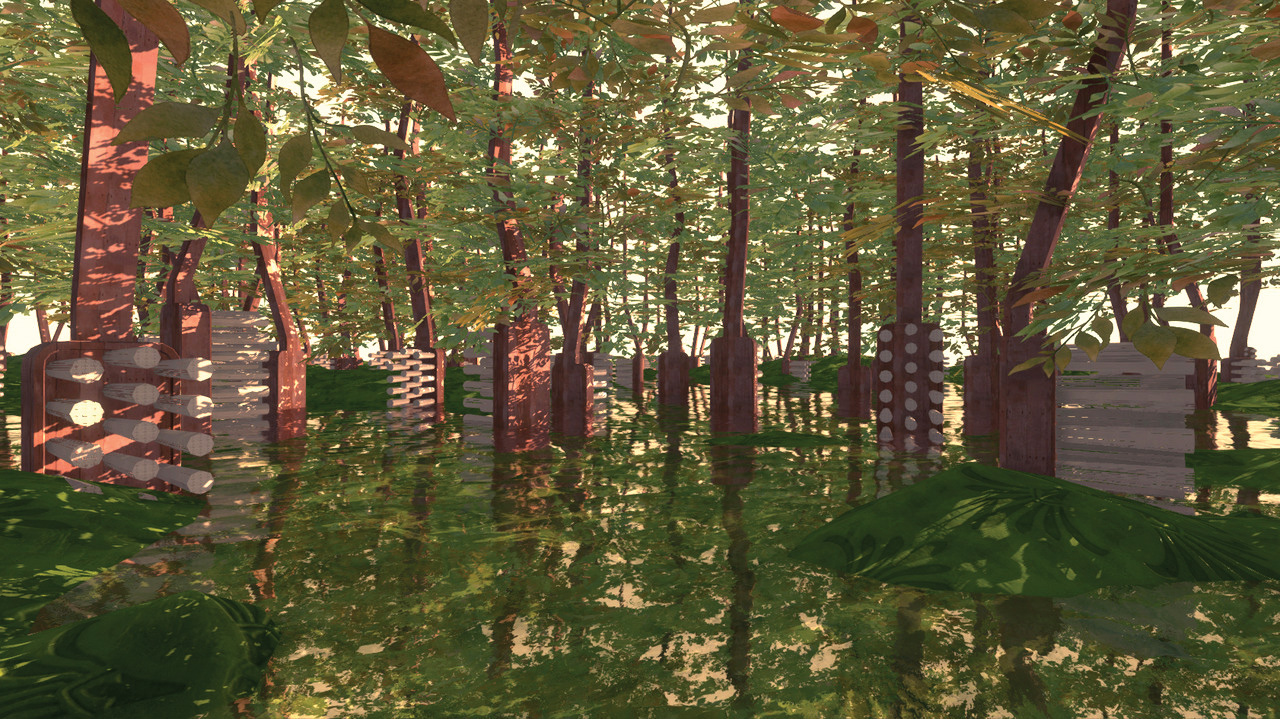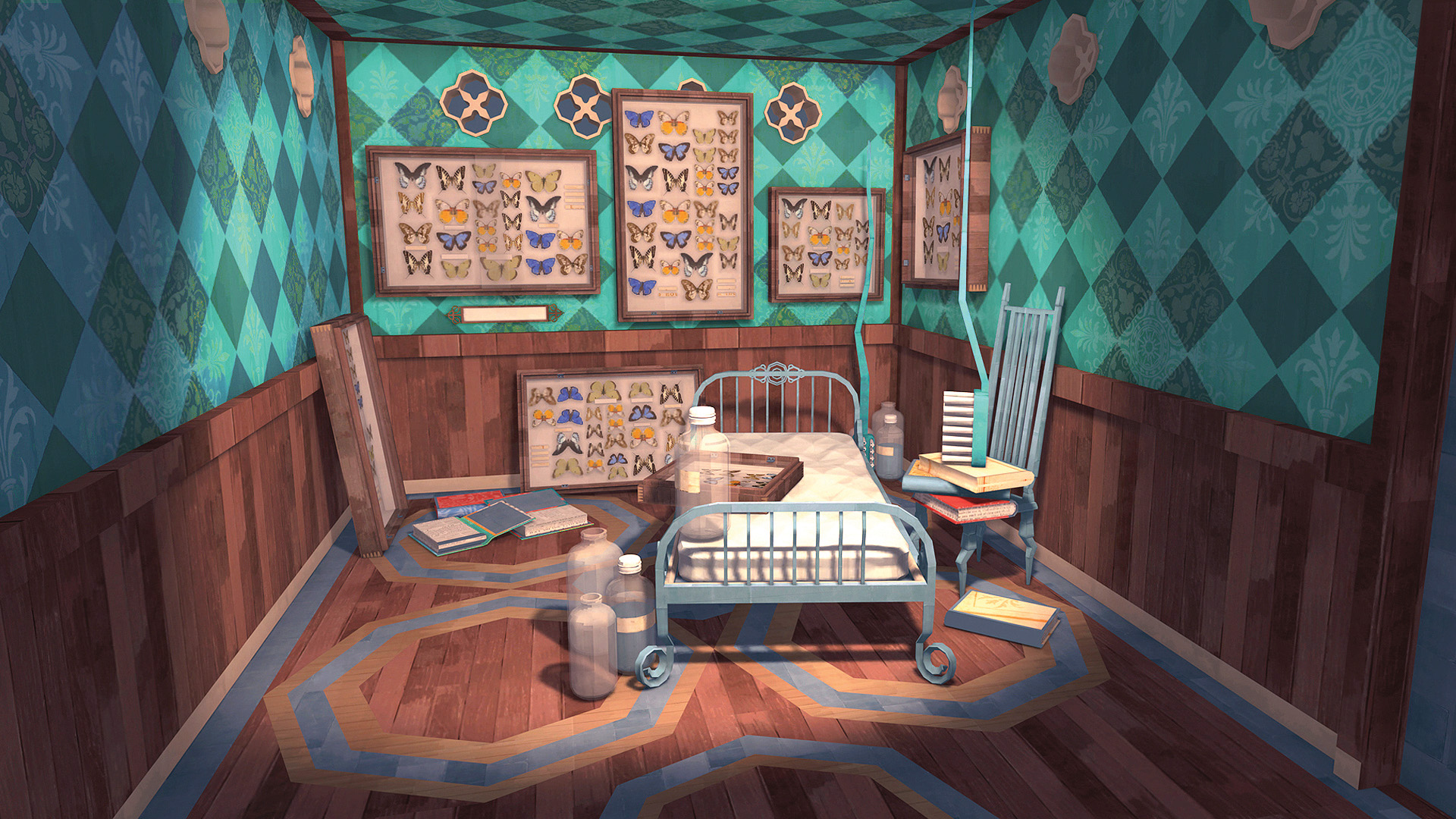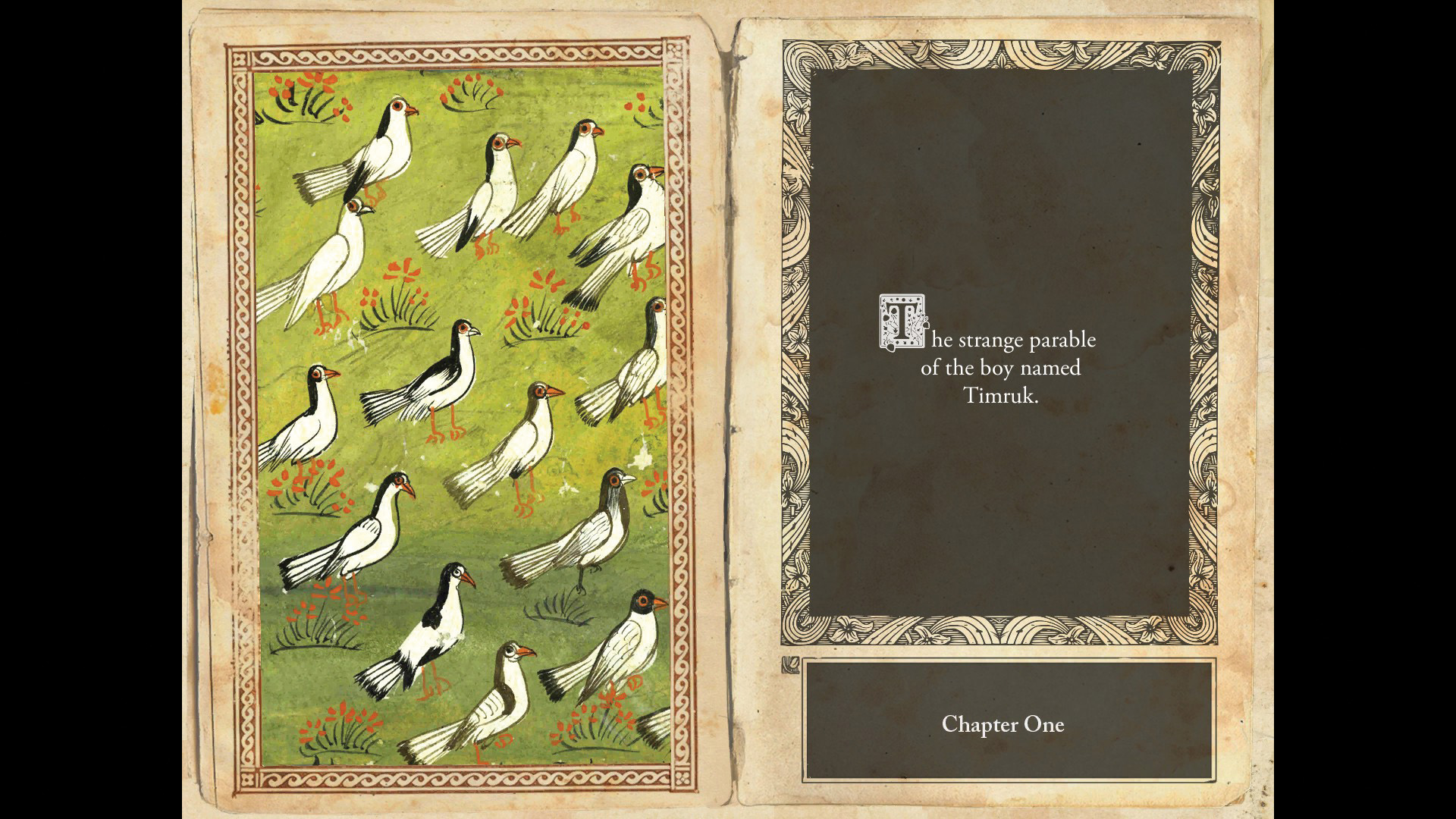The story of Somewhere, a game that might not exist
Exploring the fascinating projects of Studio Oleomingus.

Somewhere is a game which Studio Oleomingus has been working on for more than half a decade. I can describe it. I have seen screenshots and sketches from it and relating to it. I have written about it. I’m writing about it now. Yet Somewhere might not exist.
My conversation is with Dhruv Jani, the author and artist who, with programmer Sushant Chakraborty, makes up the studio. Somewhere, he tells me, began life as a single game. “A simple project where we would tell the story of Kayamgadh and its discovery by narrating it through a series of characters.”
You can catch glimpses of that project if you scroll back far enough through the duo’s Tumblr. The game you’ll find being outlined in 2013 has figures who act as vessels through which the player can interact with the game, swapping from one to another for new perspectives via a sneaking stealth process. Screenshots from the blog give a sense of a game being developed, with the team figuring out character models and implementing ideas.
There are other games and experiences which have sprung up around the main game. A Museum of Dubious Splendors is one of the most recent, and it intersperses poetic writing with a surreal museum space. You’ll read an account of a mysterious object found by a historical figure and then find yourself in a gorgeously panelled and wallpapered room facing a gigantic floating tube of toothpaste while rain falls around you and two mannequin arms reach for the ceiling.
Menagerie is from 2015. It’s an experience set in an overgrown bathroom where a wooden man strikes up a conversation with you. Walking away from him spawns more wooden men, all keen to converse with you. As Oleomingus said at the time: “As you generate more copies of the dialogue it will become progressively harder to comprehend the conversation.” I believe I likened it to a networking event. Menagerie is not explicitly part of Somewhere but shares the same art style, repeats the same motifs, and plays with a similar strand of conversational plurality.
“What began as a singular project is now apportioned across several mediums and many small experiments,” says Jani. “And the first, modest story that we set out to tell has mutated beyond recognition, becoming instead a dense historical text that drives our next game: Under A Porcelain Sun.”
Under a Porcelain Sun is a text-driven adventure game scheduled to come out later in 2018 on PC. It’s described as an absurd adventure game set during the tumult of the annexation of Southern Malwa, and the screenshots reveal the studio’s familiar motifs and colour palette. There’s a shark suspended in midair, oversized chairs whose legs form a forest, beautiful patterned tiles and butterfly collections decorating the walls.
Unravelling cities

The studio has another story set within that same region and the same time period: An Indivisible Margin of Error. But you won’t find that one on a games platform. Instead, it was a site-specific installation which formed part of an experimental retrospective of the famed architect Charles Correa in Jaipur, Northern India.
Keep up to date with the most important stories and the best deals, as picked by the PC Gamer team.
Jani also mentions Langoors in the Labyrinth which I hadn’t heard of but which, he says, “examines the unravelling of a city through the lens of the author of Kayamgadh’s history, Mir UmarHassan.”
The thing which these stories (and others which have emerged from the studio over the years) have in common is that they stem from Somewhere. As the idea of Somewhere has grown and developed, Oleomingus has built up what Jani describes as “a considerable amount of intricate lore” which is written in such a way that it intertwines and blurs into actual history of the Western Indian states in the early 19th century.
Jani explains, “As we delved into Colonial history we started to mask our writings for the game by creating the persona of Mir UmarHasan, a fictitious Gujarati poet writing in early ’60s, whose works we are ostensibly adapting in game form.”
Oleomingus operates in uncertain spaces
Creating the fiction and then adapting it rather than trying to build the fiction as an interactive thing from the start was important. It made it easier for the team to navigate their literary influences from traditional writing forms and it also meant Somewhere could become a transmedia enterprise, with each element pulling from the same core body of work but being adapted in a way that suited the demands of a specific project.
So these smaller satellite projects exist. I’ve played the ones which have emerged online and read up about the ones taking place far away from me. But there is a line from one of the story snippets Oleomingus posted early on in the game’s life and which has stayed with me: “You perceive my house as I describe it to you.”

The idea here is that the listener’s experience of a space is mediated by the person telling them about it. Generally you trust that account, but it might be fictional, or it might reveal the biases or the interests of the teller. Two people can describe the same space and evoke entirely different experiences. Following Oleomingus’s work over time, that idea of experiencing events or places through the lens of other people pops up again and again.
At some point in the last couple of years I realised that the idea had become so dominant that I no longer thought of Somewhere as an actual game which would be playable at any point, but—like the mysterious city of Kayamgadh—as something I would only ever glimpse via these other games and other performances.
That’s not to say that Somewhere has never existed. There have been at least two demo builds for the project and elements like the architecture and the body-swapping were real enough. But the duo’s understanding of what Somewhere is and the form it takes has shifted.
Jani says that the team discarded the body-swapping idea after a demo build called Rituals because it wasn’t working in conjunction with the stories Oleomingus was telling. Instead the studio preferred “to use simpler and subtler methods of creating plurality”.
He puts forward a new version of Somewhere’s characters where they are no longer distinct entities, entirely separate from one another, but form a cast which can merge or diverge: “People in the story, reducing into single entities because they collide with each other on a map and amalgamate or characters splitting apart in a mitotic act of generating replicas with errors in their recollection of their narratives. This is how the fissures of views and stories now manifest themselves in the game.”
That idea is also analogous to how I think Oleomingus sees the relationship between different fields of study or expertise. They aren’t disconnected but flow into one another “as a continuum of a cycle of arguments, from linguistics to evolutionary biology, from architecture to history and from thermodynamics to literature”.
This description of character interaction is really interesting, but it also further reduces the sense of Somewhere as a concrete project that I can latch onto. I ask whether Somewhere actually exists in the sense that a traditional game does or whether it’s just something the player sees through these other facets.

“Somewhere, like the city of Kayamgadh, does not exist,” says Jani. “You are right, it is always meant to be seen through the occluded lens of our other work. In that it is a little like R.K. Narayan’s town of Malgudi or E.M. Forster’s Marabar caves. A trope of postcolonial fiction stretched to the extreme, and applied to the very form of telling these stories.”
He also points to the work of Cardboard Computer, the creator of Kentucky Route Zero and associated ancillary projects, as exploring in similar territory—satellite works which orbit a main game that itself “seeks to draw very pertinent parallels to actual people, characters and literary forms.”
I considered following up to try and pin down whether one of the facets through which we would glimpse Somewhere would be a game titled Somewhere. What stopped me, though, was the fact that I don’t actually want an answer. Part of my enjoyment of Studio Oleomingus’s work is that I enjoy the blurring of fact and fiction, and I love that there is a studio whose magnum opus might just not exist in a tangible sense while still being influential and beautiful.
The enjoyment of not knowing can be complicated, though. Fictions and metafictions of this sort can be difficult because players sometimes feel stupid or embarrassed by being ‘taken in’—that maybe they are the butt of an elitist or obscure joke, rather than part of the experience. Sometimes the desire to pin down which parts are ‘true’ and which are not starts to dominate, converting a fluid exploration into something closer to a test which you could pass or fail.
With that in mind, I ask what players’ responses have been like to the studio’s games, and how much they have wanted to interrogate what is ‘true’.

“Predominantly, and perhaps because we release games across long intervals and work slowly, most people approach each individual game as a standalone story or experience,” explains Jani, “often believing a portion of the fictitious context we provide to be true.
“This often lends an aura of strange authenticity. For example, many of those of who have played A Museum of Dubious Splendors feel compelled to mention that is an adaption of some vernacular work. And their patient journey through the game rewards them with literature from a source that’s otherwise alien to them, and one that is being benevolently brought to this form. When of course it is all just a mischievous nesting of stories within stories.”
He continues, “On the other hand, we have had people write to us and mention the exact authors and texts that our work reminds them of—which often turn out to be accurate and precisely the ones we chose to emulate when crafting our stories. Our favourite response thus far has been when an expatriate wrote to us to say our work reminded her of home in Pakistan and the nostalgia she associated with it.”
On the subject of A Museum of Dubious Splendors, this is an excerpt from the ‘About This Game’ section of its Steam storefront page (the wording is very slightly different from its Itch.io entry):
“These tales, have been recreated from a collection of stories by Mir UmarHassan, a Gujarati poet whose works have proven notoriously difficult to translate because of the mellifluous use of Urdu and Hindi in his compositions. The collection, entitled ‘in Dubious Splendor’, was written (in Gujarati) in 1962 for the Malwa Chronicle, but the stories therein were mangled and edited without the author’s permission prior to their publication in serialised form.”
The description in the top right of the game page notes that this is “an irreverent rumination” and a “quiet game about prosaic objects and spurious histories”. So the information that this is a fiction is offered (although gently, rather than with any fanfare). But if you skim past it or don’t interrogate it, it’s easy to take the blurb, which actually forms part of the broader fiction of Somewhere, as an authentic explanation, so plausibly is it written. The current Steam page for Under a Porcelain Sun is a little different in that both chunks of text seem to sit more clearly outside of the game’s fiction. Each references genre and camera positioning (narrative adventure, first-person) and there are no ambiguous historical figures, just a tantalising selection of fantastical characters and settings—wax people who melt at noon, salt bandits, castles of glue...
Confounding expectations

I wonder whether this slight shift in how the experience is pitched to players will result in different experiences of the fiction. Or perhaps, when this particular experience arrives later in the year, I’ll suddenly realise that the sources of uncertainty have simply shifted to another location, seeping in undetected by my current radar.
But to go back to what players have been making of Oleomingus’s work so far, “There is also often absolute bewilderment as to what the game is ‘supposed to do’ or why it exists,” says Jani. “The literary threads that bind it together seem to many players too loose and too irrelevant to merit the sort of engagement with the fiction that the game requires.
“But for our locally exhibited work it is much easier for people to draw connections between fictitious events and actual game lore. It also then enables us to participate in discourse surrounding other disciplines like postcolonial studies, vernacular literature and architecture.”
An Indivisible Margin of Error is one of those works. The Charles Correa retrospective in which it was exhibited was called When is Space? and Jani notes: “We are arguing that videogame spaces are difficult to inhabit because they are perpetual ruins, an argument created in response to people playing our work during the exhibition, and several conversations with those who were skeptical of its form or intent.”
Oleomingus operates in uncertain spaces, using real projects to indirectly tell the story of a fictional place. Regardless of whether a game called Somewhere comes out, it has expanded into a fascinating (and hugely ambitious) web of evocative text and distinctive, arresting art. As Jani puts it, “At the heart of this effort is a firm belief in the potent function of stories and their capacity to record, mutate and induce change in language, political history, culture and built form.”
We finish with me asking him to tell me the story of an image from Somewhere—a forest of toothbrushes. “I could tell you that the toothpaste forest is an adaptation of a folklore,” he says. “The tale of a prince who is wrongly accused and exiled from his kingdom, and who decides to revenge himself by becoming the ruler of a land of giants and by waging war on those who exiled him. And that the only depiction of this fable from the company period, is in the form of a lithograph at the Victoria Museum, which shows the prince seated on a throne surrounded by oversized everyday objects in the giant’s realm, including a large tree-like toothbrush in the corner…but that would be as fictitious as many of our other stories!”

